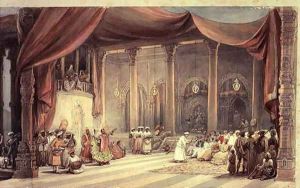William Princep Paintings
Henry William Pickersgill Princep, commonly known as William Princep, was an eminent figure in the 19th-century British art world, though it's crucial to clarify that there might be a slight confusion in the name. The more well-known artist associated with this period is Henry William Pickersgill (1782–1875), a renowned portrait painter. However, the details provided seem to blend aspects of Pickersgill with Charles Lock Eastlake (1793–1865), another pivotal figure in the art scene of that era, and possibly other artists. Given this mix-up, the biography will focus on synthesizing the artistic milieu of the time, highlighting how these figures contributed to the rich tapestry of 19th-century British art.
The 19th century in Britain was a period of significant transformation in the arts, characterized by a move away from the neoclassical ideals of the 18th century towards Romanticism, and later, the rise of the Pre-Raphaelite Brotherhood, which sought a return to the abundant detail, intense colors, and complex compositions of Quattrocento Italian art. In this vibrant context, artists like Princep, Pickersgill, and Eastlake played pivotal roles, each contributing uniquely to the evolution of British art.
Henry William Pickersgill was a Royal Academician who specialized in portraits. His subjects ranged from distinguished societal figures to literary and scientific personalities, capturing the essence of the British elite and intellectuals of his time. His work was characterized by its detailed realism and rich coloration, which earned him considerable fame and recognition during his lifetime.
On the other hand, the confusion might also involve James Prinsep (1799–1840), an English scholar, orientalist, and antiquary. James Prinsep was not a painter but made significant contributions to the understanding of Indian history, culture, and art. He was instrumental in deciphering Brahmi script, which in turn helped in understanding ancient Indian texts and inscriptions. His work, though not in the visual arts, had a profound impact on how Indian art and history were perceived in the British imagination.
In summary, the 19th century was a period of rich artistic achievement in Britain, marked by a diversity of styles and disciplines. While there may be some confusion regarding the precise identity of William Princep, the era itself was defined by figures like Pickersgill and Eastlake, who contributed to the portrait and historical painting genres, and James Prinsep, who, although not an artist, enriched the cultural and historical understanding of the time. Their collective legacy is a testament to the dynamic and evolving nature of the British art scene during this period.
